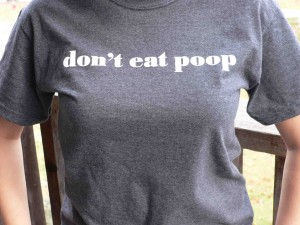My mother contracted undulant fever as a child in the 1940s.
My grandfather, to his credit, promptly got rid of the dairy cows, and went into potatoes,  and then became the asparagus baron of Canada.
and then became the asparagus baron of Canada.
Scott Weese, an OK hockey player and vet prof at the University of Guelph, where I used to ply my trade, delves into the hygiene hypothesis on his Worms & Germs Blog.
Yes, I do say, don’t eat poop, but the amendment would be, if you do, cook it.
And like Weese, I’ve heard the same question for 20 years on the speaker and blog circuit: is our food too clean?
How clean to we want things to be, asks Weese, and can we be too clean? Furthermore, does reduction in our exposure to microorganisms predispose us to various diseases, such as allergic and inflammatory diseases? The answer to both of these is presumably yes. However, what level of clean is good and what level is excessive?
In a hospital, we want clean… very clean. We have a highly susceptible population and lots of bad bugs in circulation. We want close attention paid to disinfection and thorough hand hygiene in hospitals, no doubt about it. But what about in the general population? Antibacterial soaps are not generally recommended for households because there’s no evidence they are needed and they might increase the likelihood of antibiotic resistance (since bacteria that become resistant to antibacterial agents in soaps can also be resistant to some antibiotics). We don’t need high-level disinfection as a routine practice all over the house. At certain times and in certain areas, sure, it’s certainly still a good idea. For example, if you’re working with raw chicken, careful attention to hygiene and surface disinfection is important because of the high likelihood of exposure to some important pathogens (e.g. Salmonella). But do we need to be spraying disinfectants around the rest of the house on a routine basis (as some TV commercials indicate)? Probably not.
Being a germaphobe can be good, but maybe it can also be bad. We need to think about the role of this complex and massive (yet still poorly defined) microbial population that lives  with us. How much exposure to bacteria from different sources is actually needed for health, especially in kids? How much is harmful? There has to be a middle ground.
with us. How much exposure to bacteria from different sources is actually needed for health, especially in kids? How much is harmful? There has to be a middle ground.
Watching daughter Sorenne slowly recover from whatever made her stronger back in April via 14 vomits and five diarrheal episodes reinforced, to me, how little is known.
The concept of exposing people to germs at an early age to build immunity is known as the hygiene hypothesis.
I’m not an immunologist, but the idea makes biological sense; I do, however, get concerned with the details, and generalizations.
We know immune systems take several years to develop in young children, and things start to go downhill after 55. (Freedom 55?). A little dirt may be good for kids, but there will always be some who, through genetics, environment and other unknowns, will be more susceptible to disease than others. And we’re not smart enough to know who those individuals are. The good ole’ days usually included stories about a family that lost a kid.
My mother came close.
Then there’s the policy. I can’t imagine the agriculture minister or secretary announcing that investments in a lot of this food safety stuff would be better spent on other societal priorities. We’ve done a cost-benefit analysis and decided it’s better for everyone to get a little sick. We’re going to lose a few, and we don’t know who those few (or many) are, but it’s a cost-effective approach.
 I was born on her 21st birthday
I was born on her 21st birthday

